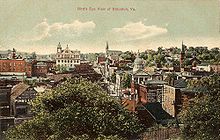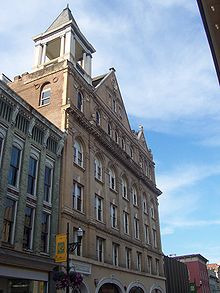- Staunton, Virginia
-
Staunton — City — West Beverley Street Nickname(s): Queen City of the Shenandoah Valley Location of Staunton, Virginia Coordinates: 38°9′29″N 79°4′35″W / 38.15806°N 79.07639°WCoordinates: 38°9′29″N 79°4′35″W / 38.15806°N 79.07639°W Country United States State Virginia Incorporated 1871 Area - Total 19.7 sq mi (51.0 km2) - Land 19.7 sq mi (51.0 km2) - Water 0.0 sq mi (0.0 km2) Elevation 1,417 ft (432 m) Population (2010) - Total 23,746 - Density 1,210.3/sq mi (467.3/km2) Time zone Eastern (EST) (UTC-5) - Summer (DST) EDT (UTC-4) ZIP codes 24401-24402 Area code(s) 540 FIPS code 51-75216[1] GNIS feature ID 1500154[2] Staunton (/ˈstæntən/ stan-tən) is an independent city within the confines of Augusta County in the commonwealth of Virginia. The population was 23,746 as of 2010.[3] It is the county seat of Augusta County.[4]
It is known for being the birthplace of Woodrow Wilson, the 28th U.S. president, and the home of Mary Baldwin College, a women's college. The city is also home to Stuart Hall, a private co-ed preparatory school, as well as the Virginia School for the Deaf and Blind.
Staunton is the larger of the two principal cities of the Staunton-Waynesboro micropolitan statistical area, which covers Augusta County and the cities of Staunton and Waynesboro.[5] The micropolitan area had a combined population of 116,299 in 2009.[3]
Contents
History
The area was first settled in 1732 by John Lewis and family. In 1736, William Beverley, a wealthy planter and merchant from Essex County, was granted by the Crown over 118,000 acres (478 km²) in what would become Augusta County. Surveyor Thomas Lewis in 1746 laid out the first town plat for Beverley of what was originally called Beverley's Mill Place.[6] Founded in 1747, it was renamed in honor of Lady Rebecca Staunton, wife to Royal Lieutenant-Governor Sir William Gooch.[7] Because the town was located at the geographical center of the colony (which then included West Virginia), Staunton served between 1738 and 1771 as regional capital for what was known as the Northwest Territory, with the westernmost courthouse in British North America prior to the Revolution.[8] By 1760, Staunton was one of the major "remote trading centers in the backcountry" which coordinated the transportation of the vast amounts of grain and tobacco then being produced in response to the change of Britain from a net exporter of produce to an importer. Staunton thus played a crucial role in the mid 18th century expansion of the economies of the American Colonies which, in turn, contributed to the success of the American Revolution.[9] It served as capital of Virginia in June 1781, when state legislators fled Richmond and then Charlottesville to avoid capture by the British.
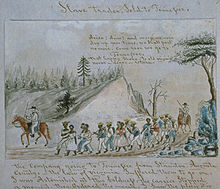 Lewis Miller, Sketchbook of Landscapes in the State of Virginia, 1853-1867. Courtesy, Abby Aldrich Rockefeller Folk Art Museum, Colonial Williamsburg Foundation, Williamsburg, Virginia; slide 84-896c.Titled, “Slave trader, Sold to Tennessee.” The caption states: “ The company going to Tennessee from Staunton, Augusta county, the law of Virginia suffered them to go on. I was astonished at this boldness, the carrier stopped a moment, then ordered the march, I saw the play it is commonly in this state, when the negro’s in droves Sold.”
Lewis Miller, Sketchbook of Landscapes in the State of Virginia, 1853-1867. Courtesy, Abby Aldrich Rockefeller Folk Art Museum, Colonial Williamsburg Foundation, Williamsburg, Virginia; slide 84-896c.Titled, “Slave trader, Sold to Tennessee.” The caption states: “ The company going to Tennessee from Staunton, Augusta county, the law of Virginia suffered them to go on. I was astonished at this boldness, the carrier stopped a moment, then ordered the march, I saw the play it is commonly in this state, when the negro’s in droves Sold.”
Slaves were held in Staunton, as they were throughout the southern states and some of the northern. For instance, in 1815, a slave named Henry ran away from John G. Wright's Staunton plantation. Wright later placed an ad in the Daily National Intelligencer in Washington, D.C. seeking Henry's return. This ad is notable in its genre for the fact that it notes that Henry was an excellent cook and was widely travelled, having been to the West Indies.[10]
Located along the Valley Pike, Staunton developed as a trade, transportation and industrial center, particularly after the Virginia Central Railroad arrived in 1854. Factories made carriages, wagons, boots and shoes, clothing and blankets.[11] In 1860, Staunton Military Academy was founded. By 1860, Staunton had at least one pro-union, anti-slavery newspaper (the Staunton Spectator) and at least one pro-secession, pro-slavery newspaper (the Staunton Vindicator).[12] The Spectator ran editorials before the war urging its citizens to vote for union,[13] while the Vindicator ran, e.g., stories reporting on "unruly" slaves mutilating themselves to escape being sold.[14] During the Civil War, the town became an important Shenandoah Valley manufacturing, staging area and supply depot for the Confederacy. On June 6, 1864, Union Major General David Hunter arrived with 10,000 troops to cut supply, communication and railway lines useful to the rebellion. The next day, they destroyed the railroad station, warehouses, houses, factories and mills. Union soldiers looted stores and warehouses and confiscated supplies.[11]
On July 10, 1902, Staunton became an independent city.[15]
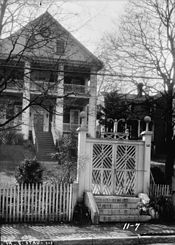 Entrance gates, Stuart-Robertson House, Staunton, Historic American Buildings Survey
Entrance gates, Stuart-Robertson House, Staunton, Historic American Buildings Survey
Western State Hospital
Main article: Western State Hospital (Virginia)Staunton is also home to the former Western State Lunatic Asylum, a hospital for the mentally ill, which originally began operations in 1828. The hospital was renamed Western State Hospital in 1894.
In its early days, the facility was a resort-style asylum. It had terraced gardens where patients could plant flowers and take walks, roof walks to provide mountain views, and many architectural details to create an atmosphere that would aid in the healing process. However, by the mid 19th Century, this utopian model of care had vanished, replaced by overcrowding in the facility and the warehousing of patients. Techniques such as "ankle and wrist restraints, physical coercion, and straitjackets" were used.[16] After the passage of the Eugenical Sterilization Act of 1924 in Virginia,[17] patients were forcibly sterilized at Western State[18] until the law authorizing the practice was repealed in the 1970s.[19] Later, electroshock therapy and lobotomies were practiced at the facility.[16]
Western State vacated the property in the 1970s when the hospital moved to its present site near Interstate 81. The facility was then converted to the Staunton Correctional Center, a medium-security men's penitentiary. The prison closed in 2003, and the site was left vacant for several years. In 2005, the state of Virginia gave the property to the Staunton Industrial Authority.[20]
The site is now a mixed-use neighborhood called The Villages at Staunton. The first building that was renovated was The Bindery, which holds residential condos. The development team consisted of Frazier Associates of Staunton, Folsom Group of Charlottesville, Miller & Associates of Richmond, and The Arcadia Land Company of Wayne, Pennsylvania.[16]
Geography
According to the United States Census Bureau, the city has a total area of 19.7 square miles (51.0 km²), all land. Staunton is located in the Shenandoah Valley in between the Blue Ridge and Allegheny Mountains of the Appalachian Mountains. It is drained by Lewis Creek. Lewis Creek flows into the Shenandoah River, which flows into the Potomac, and eventually to the Chesapeake Bay.
Demographics
As of the census[1] of 2000, there were 23,853 people, 9,676 households, and 5,766 families residing in the city. The population density was 1,210.3 people per square mile (467.3/km²). There were 10,427 housing units at an average density of 529.1 per square mile (204.3/km²). The racial makeup of the city was 83.29% White, 13.95% Black or African American, 0.22% Native American, 0.46% Asian, 0.01% Pacific Islander, 0.52% from other races, and 1.55% from two or more races. Hispanic or Latino of any race were 1.11% of the population.
There were 9,676 households out of which 24.9% had children under the age of 18 living with them, 44.4% were married couples living together, 11.7% had a female householder with no husband present, and 40.4% were non-families. 34.7% of all households were made up of individuals and 14.3% had someone living alone who was 65 years of age or older. The average household size was 2.19 and the average family size was 2.81.
In the city the population was spread out with 19.8% under the age of 18, 10.2% from 18 to 24, 27.8% from 25 to 44, 24.1% from 45 to 64, and 18.0% who were 65 years of age or older. The median age was 40 years. For every 100 females there were 89.1 males. For every 100 females age 18 and over, there were 87.0 males.
The median income for a household in the city was $32,941, and the median income for a family was $44,422. Males had a median income of $30,153 versus $22,079 for females. The per capita income for the city was $19,161. About 7.7% of families and 11.7% of the population were below the poverty line, including 15.9% of those under age 18 and 10.7% of those age 65 or over.
As of 2008, Staunton was suffering one of Virginia's "most severe population declines", with the immigration rate and the birth rate failing to make up for the emigration rate and the death rate. The population declined almost 4% between 2000 and 2007, according to a study done by Charles Spar of the University of Virginia.[21]
Police in the Staunton region estimate that there are over 300 gang members in the city. These gang members are active in the Crips, the Bloods, and MS-13, as well as in purely local gangs.[22]
Arts and culture
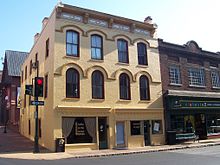 Coffee On The Corner building, with Blackfriars Playhouse and the Stonewall Jackson Hotel behind
Coffee On The Corner building, with Blackfriars Playhouse and the Stonewall Jackson Hotel behind
Staunton is home to the American Shakespeare Center, a theatrical company centered at the Blackfriars Playhouse, a replica of Shakespeare's Blackfriars Theatre. The Woodrow Wilson Presidential Library is open for visitors, as well as the Museum of American Frontier Culture, which provides an insider's look at life in early America.
Staunton is also home to the Statler Brothers, country music legends who until 1994 performed free concerts at the annual Fourth of July celebration, accompanied by other country music artists. Statler Brothers members Don Reid, Harold Reid, and Phil Balsley grew up and still reside in the city.
Folksinger Phil Ochs attended Staunton Military Academy between 1956 and 1958, where he played clarinet in the marching band. His exposure to the country music played on local radio, quite different from what he was used to hearing in his home state of Ohio, was a significant influence on his decision to become a singer.[23]
Film
Downtown Staunton and Sherwood Avenue were used in the American Civil War film Gods and Generals. The local Shenandoah Valley Railroad as well as a number of nearby houses were used in filming of Hearts in Atlantis. In 1993, a portion of the Showtime production of Assault at West Point: The Court-Martial of Johnson Whittaker was filmed here. In the summer of 2006, some scenes for the movie Evan Almighty were also filmed in Staunton. Some scenes for Familiar Strangers were also filmed in Staunton in 2007.
Architecture
Staunton is home to nearly 200 buildings designed by architect Thomas Jasper Collins (1844–1925), who worked in various styles during the Victorian era.[24] His firm, T. J. Collins & Sons, is still in business.
The city was once home to about ten hotels. One of them that is still in operation is the Stonewall Jackson Hotel. It was renovated in the early 2000s, and is now in operation as a hotel and a conference center. The Ingleside Resort is also still in operation. During World War II it was used by the INS as a detention center for enemy aliens held under Executive Order 9066.[25] Some of the hotels that are no longer in operation are The Virginia Hotel, the Eakleton Hotel, the Valley Hotel, and the American Hotel. All of these buildings are still standing except for the Virginia Hotel, which was demolished in 1930 to make way for a planned addition to the Stonewall Jackson Hotel which was never built. The New Street Parking Garage now stands on the site. Among the houses in Staunton on the National Register of Historic Places is The Oaks, at 437 East Beverley Street. An 1840s structure, it was modified and enlarged in 1888 by famed Civil War cartographer Jedediah Hotchkiss.
Sports
In 1894, Staunton fielded a team in the Virginia League (1894-1896): The Hayseeds.[26] In 1914, the city fielded a team in the Virginia Mountain League: The Staunton Lunatics.[26] The Lunatics moved to Harrisonburg in July 1914, just before the league disbanded.[27] From 1939 to 1942, the city fielded a team in the Virginia League (1939-1942): the Staunton Presidents.[26] Staunton currently has no minor league baseball, but the Staunton Braves represent the city in the Valley Baseball League, a collegiate wooden bat league that plays in the Shenandoah Valley.
Parks and recreation
- Betsy Bell Wilderness Park — a 70 acres (280,000 m2) mountaintop park with a 1,959 feet (597 m) observation platform
- Gypsy Hill Park — a 214 acres (870,000 m2) multi-use facility with a golf course, football and baseball stadiums, gymnasium, lake, two playgrounds, three youth baseball fields, public swimming pool, volleyball court, horseshoe pits, tennis courts, the Gypsy Express mini-train, the Duck Pond, a skatepark, a bandstand, and several pavilions. Until the Staunton city parks were integrated, Gypsy Hill Park was only open to whites[28] except for one day a year, which was set aside for other races to use the park.[29]
- Montgomery Hall Park — a 148 acres (600,000 m2) multi-use facility with softball and soccer fields, tennis courts, disc golf course,[30] playgrounds, picnic shelters, hiking and fitness trails, and a swimming pool, which is nonoperational for budgetary reasons.[31] The offices of the Department of Parks and Recreation are at the Irene Givens Administration building, which also includes a kitchen, activity room, and conference room which are available for public use. Montgomery Hall Park was opened in 1950 after much agitation by non-white residents of Staunton.[32] Before segregation ended in the mid 1960s, Montgomery Hall park was the only park in the city open to African-Americans[33]
- Booker T. Washington Community Center — formerly the segregated Booker T. Washington High School, although according to the court which decided Bell v. Staunton Board of Education, the term "high school" was a misnomer, as the school also contained "first, second, and seventh grade classes and two special mentally retarded classes as well as the eighth through the twelfth grades."[34]
- Nelson Street Teen Center — closed (as of 2011) due to budget cuts.[35]
Government
Staunton operates under a council-manager form of government. In 1908, Staunton was the first city in the United States to give an appointed employee authority over city affairs through statute. In 1912, Sumter, S.C., was the first U.S. city to implement the council-manager form of city government.[36] The city of Staunton refers to itself on its website as the "birthplace of President Woodrow Wilson, and the city manager form of government."[37]
Staunton is part of Virginia's 6th congressional district.
Education
Black Virginians were largely barred from education until Reconstruction.[38] The first school in Staunton which allowed African-Americans to attend was established by the Freedman's Bureau under the supervision of the commanding general of the occupying Union army in late 1865. Arrangements were made to bring in women from the North as teachers, and the jury rooms of the Augusta County Courthouse, located at 1 E. Johnson Street, were to be used as classrooms. The court protested this plan, however, and it is possible that another location was found.[39]
Attorneys for the city of Staunton submitted a plan for the desegregation of its public schools in 1965 by eliminating all negro schools in time for the 1967-68 school year, which was approved by the Department of Health, Education and Welfare. However, the implementation of this plan was delayed to such an extent that a group of African-American parents brought suit in the United States District Court for the Western District of Virginia against the city. This case, Bell v. School Board of Staunton, was decided on January 5, 1966, with the court stating that the delay was a violation of the rights of the students under the Fourteenth Amendment and ordering that the schools and their faculty be desegregated in time for the 1966-67 school year.[34]
The Staunton city school district is one of about twenty left in Virginia which take elementary school students out of class for Bible lessons on a voluntary basis, a practice known as Weekday Religious Education. Although the U.S. Supreme Court ended taxpayer funded religious education in 1948 in McCollum v. Board of Education, four years later they opened the door for privately funded voluntary classes held during school hours but away from school premises in Zorach v. Clauson. In 2005, a group of parents in Staunton asked the school board to halt the practice.[40] However, the challenge was unsuccessful, and the Bible classes are still being taught (as of July 2011).[41]
Public
- Shelburne Middle School
- Robert E. Lee High School
- Virginia School for the Deaf and Blind
Private
- Stuart Hall School -- preparatory school (boarding for girls, day school for coed)
- Grace Christian School-- Coed Christian School for Pre-K to 12th Grade
- C. F. Richards Jr. Academy—coed Seventh-Day Adventist school
- Mary Baldwin College -- dormitories for women, commuter for coed
Media
- The News Leader, local newspaper. Owned by the Gannett Company.[42]
- WHSV. ABC affiliate in Harrisonburg.
Infrastructure
Transportation
See also: Staunton (Amtrak station)Amtrak provides service to Staunton under the Cardinal route. The route serves Staunton's downtown train station. It also serves as the closest station for the nearby cities of Harrisonburg and Lexington.
Staunton had a municipal bus system during the 20th century, known as the Staunton Transit Service, but it was dissolved in 1989.[43] In 1944, World War II veteran S. Melvin Johnson wrote to Truman Gibson, assistant to William H. Hastie, advisor to Secretary of War Henry L. Stimson, regarding segregated seating on the Staunton Transit Service and stating that returning African-American soldiers would not stand for such conditions.[44] This letter was an indication of the role that African-American veterans would later play in the American civil rights movement. Currently, the Staunton Trolley provides fixed-route bus service throughout Staunton.[45] It includes three routes - the Red Route, the Green Route and the Silver Route. The Green Route connects to the City's Amtrak station. The Coordinated Area Transportation Services (CATS) operates a demand-response service throughout the Staunton area, as well as a fixed shuttle service between the downtown areas of Staunton and Waynesboro.[46]
The city is located very close to the intersection of I-81 and I-64. VA-262 provides a partial beltway around the city. US-11 passes through the city.
The nearest commercial airport is Shenandoah Valley Regional Airport in Weyers Cave, Virginia.
Healthcare
- Commonwealth Center for Children and Adolescents (formerly the DeJarnette Center after famed eugenicist Joseph DeJarnette) psychiatric facility
- Western State Hospital (Virginia) psychiatric facility
Notable residents
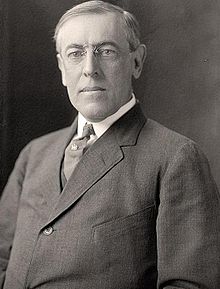 President Woodrow Wilson
President Woodrow Wilson
- Diana Adams, dancer
- John Brown Baldwin, legislator
- Mary Julia Baldwin, educator
- Phil Balsley, baritone singer
- Larry Boerner, baseball pitcher
- Allen Caperton Braxton, segregationist and Staunton representative to the revanchist Virginia state constitutional convention of 1902.[47]
- John Breckinridge, senator and attorney general
- John Brown, lawyer and statesman
- Joseph Calhoun, congressman
- William Christian, soldier and politician
- Gertrude Harris Boatwright Claytor, poet
- George M. Cochran, judge
- John E. Colhoun, senator and lawyer
- Joseph W. Fifer, governor of Illinois
- Alexander Hart, major in the Confederate Army
- Francis Collins, geneticist
- Joseph DeJarnette, psychiatrist and eugenicist
- Dave Fultz, baseball center fielder
- William Haines, film actor and interior designer
- Wade H. Haislip, four-star general
- Emmett Hanger, politician
- Kenton Harper, printer, soldier and politician
- John N. Hendren, judge and treasurer of the Confederate States of America
- George Moffett Harrison, judge
- Thomas D. Howie, teacher and military officer
- Alexander Humphreys, physician
- Parry Wayne Humphreys, congressman
- Carroll Knicely, editor and publisher
- Steve Landes, politician
- Samuel Augustus Merritt, delegate and judge
- James Coffield Mitchell, congressman
- Samuel Morgan, businessman, builder and manufacturer
- Eustace Mullins, white supremacist, anti-semite, conspiracy theorist, author, and publisher of Revelation Books.[48]
- Don Reid, lead singer and songwriter for The Statler Brothers
- Harold Reid, bass singer for The Statler Brothers
- Larry Sheets, baseball outfielder and designated hitter
- John B. Stephenson, sociologist
- Alexander Hugh Holmes Stuart, congressman, secretary of the interior, and chairman of the Committee of Nine
- Jacob Swoope, politician
- Malfourd W. Trumbo, politician and judge
- Thomas Wilson, congressman
- Woodrow Wilson, 28th president of the United States
- Larry Woodall, baseball catcher
- Jacob Yost, congressman
Sister cities
See also
References
- ^ a b "American FactFinder". United States Census Bureau. http://factfinder.census.gov. Retrieved 2008-01-31.
- ^ "US Board on Geographic Names". United States Geological Survey. 2007-10-25. http://geonames.usgs.gov. Retrieved 2008-01-31.
- ^ a b [1]. Weldon Cooper Center 2010 Census Count Retrieved September 9, 2011
- ^ "Find a County". National Association of Counties. http://www.naco.org/Counties/Pages/FindACounty.aspx. Retrieved 2011-06-07.
- ^ Micropolitan statistical areas and components, Office of Management and Budget, 2007-05-11. Retrieved 2008-07-27.
- ^ "Chapter 3: From the First Court to the First Indian War - Page 52, Waddell's Annals of Augusta County, Virginia, from 1726 to 1871". Roanetnhistory.org. http://www.roanetnhistory.org/bookread.php?loc=WaddellsAnnals&pgid=64. Retrieved 2009-06-14.
- ^ Room, Adrian (1989). Dictionary of World Place Names Derived from British Names. Taylor & Francis. pp. 168. ISBN 9780415028110. http://books.google.com/books?id=7JEOAAAAQAAJ&lpg=PP1&pg=PP1.
- ^ "Augusta County, VA : History". Co.augusta.va.us. http://www.co.augusta.va.us/Index.aspx?page=422. Retrieved 2009-06-14.
- ^ Gordon S. Wood (2002). The American Revolution: a history. Modern Library. p. 13. ISBN 0679640576.
- ^ "Wanted: Experienced Cook, World Traveler, Runaway Slave". The History Engine at the University of Richmond. http://historyengine.richmond.edu/episodes/view/3494. Retrieved 2 August 2011.
- ^ a b "Staunton During the Civil War". Encyclopedia Virginia. http://www.encyclopediavirginia.org/Staunton_During_the_Civil_War. Retrieved 17 August 2011.
- ^ Fritz Umbach. "A Disunited South: Augusta and its Pro-Unionists". http://courses.cit.cornell.edu/hist100.06/kim/essay.html. Retrieved 2 August 2011.
- ^ "How to Vote". The Staunton Spectator. 11 September 1860. http://valley.lib.virginia.edu/news/ss1860/va.au.ss.1860.09.11.xml. Retrieved 2 August 2011.
- ^ "Desperate Negro Woman". The Staunton Vindicator. 1861. http://www.pbs.org/wnet/slavery/experience/responses/docs8.html. Retrieved 2 August 2011.
- ^ "Virginia: Individual County and Independent City Chronologies". http://historical-county.newberry.org/website/Virginia/documents/VA_Individual_County_Chronologies.htm. Retrieved 2006-12-26.
- ^ a b c "The HooK: On architecture - Historic treatment: Staunton commits to Western State". Readthehook.com. 2006-02-02. http://www.readthehook.com/stories/2006/02/02/onarchstaunton.html. Retrieved 2009-06-14.
- ^ HOUSE JOINT RESOLUTION NO. 607 (HJ607ER), "Expressing the General Assembly's regret for Virginia's experience with eugenics", Virginia Legislative Information System
- ^ Amanda Brocato (2008). "The Campaign for Eugenics in Virginia: The Influence of Dr. J.S. DeJarnette". Augusta Historical Bulletin: 105–117.
- ^ "Eugenics in Virginia". Claude Moore Health Sciences Library, University of Virginia. http://www.hsl.virginia.edu/historical/eugenics/4-influence.cfm. Retrieved 31 July 2011.
- ^ "Virginia HB1943/SB1015". http://leg1.state.va.us/cgi-bin/legp504.exe?051+sum+HB1943. Retrieved 30 July 2011.
- ^ Michael Owens (6 February 2008). "Staunton Figure Drops Severely". Richmond Times-Dispatch. http://www2.timesdispatch.com/news/2008/feb/06/-rtd_2008_02_06_0020-ar-168878/. Retrieved 31 July 2011.
- ^ "Staunton Augusta Waynesboro Coalition anti-gang information site". http://saw2010.webs.com/forparents.html. Retrieved 31 July 2011.
- ^ Schumacher, Michael (6 September 1996). There but for fortune: the life of Phil Ochs. Hyperion. p. 27. ISBN 978-0-7868-6084-5. http://books.google.com/books?id=Vj8IAQAAMAAJ. Retrieved 14 September 2011.
- ^ "Eye candy: Staunton cures visual blues". The Hook (newspaper). 2006-01-05. http://www.readthehook.com/stories/2006/01/05/onArchitectureEyeCandyStau.html. Retrieved 2006-12-13.
- ^ Tetsuden Kashima (2004). Judgment without Trial: Japanese American Imprisonment during World War II. University of Washington Press. p. 264. ISBN 0295984511.
- ^ a b c "Staunton, Virginia Minor League City Encyclopedia". http://www.baseball-reference.com/minors/team.cgi?city=Staunton&state=VA&country=US. Retrieved 3 August 2011.
- ^ "Virginia Mountain League". baseball-reference.com. http://www.baseball-reference.com/bullpen/Virginia_Mountain_League. Retrieved 3 August 2011.
- ^ Keith Jones (12 July 2008). "Staunton's Other Park". WHSV-TV. http://www.whsv.com/news/headlines/24819959.html. Retrieved 17 August 2011.
- ^ Chris Graham (10 July 2008). "The true story of ‘Staunton’s Other Park’". Augusta Free Press. http://augustafreepress.com/2008/07/10/the-true-story-of-stauntons-other-park/. Retrieved 17 August 2011.
- ^ "PDGA Disc Golf Course Details | Professional Disc Golf Association". Pdga.com. http://www.pdga.com/course/courses_by_city.php?id=2086. Retrieved 2009-06-14.
- ^ Trevor Brown (28 April 2010). "Staunton to close Montgomery Hall Park Pool". The Staunton News Leader. http://pqasb.pqarchiver.com/newsleader/access/2020404431.html?FMT=ABS&date=Apr+28%2C+2010. Retrieved 16 August 2011.
- ^ "Area Overview: History -- African-Americans". The Staunton News Leader. http://orig.newsleader.com/communities/overview/africans.html. Retrieved 17 August 2011.
- ^ "Montgomery Hall Park entry on Staunton City website". http://www.staunton.va.us/directory/departments-h-z/recreation-parks/parks/montgomery-hall-park. Retrieved 31 July 2011.
- ^ a b "Bell v. School Board of Staunton at findacase". http://va.findacase.com/research/wfrmDocViewer.aspx/xq/fac.19660105_0000001.WVA.htm/qx. Retrieved 30 July 2011.
- ^ "Nelson Street Teen Center". City of Staunton. http://www.staunton.va.us/directory/departments-h-z/recreation-parks/facilities-rentals/nelson-street-teen-center. Retrieved 14 August 2011.
- ^ Todd Donovan, Daniel A. Smith, and Christopher Z. Mooney (2010). State & Local Politics: Institutions & Reform: The Essentials. Cengage. p. 265. ISBN 0495567892. (available on Google books)
- ^ "Economic Development". City of Staunton. http://www.staunton.va.us/directory/departments-a-g/economic-development. Retrieved 17 August 2011.
- ^ "Beginnings of Black Education". Virginia State Historical Society. 2004. http://www.vahistorical.org/civilrights/education.htm. Retrieved 5 August 2011.
- ^ "Freedmen's School". Staunton Spectator: p. 3. 31 October 1865. http://valley.lib.virginia.edu/news/ss1865/va.au.ss.1865.10.31.xml#03.
- ^ Carol Morello (23 January 2005). "Bible Breaks at Public Schools Face Challenges in Rural Virginia". The Washington Post. http://www.washingtonpost.com/wp-dyn/articles/A29266-2005Jan22.html. Retrieved 31 July 2011.
- ^ Eric Niller (28 February 2005). "Bible Study Program Divides Rural VA Town". NPR. http://www.npr.org/templates/story/story.php?storyId=4516387. Retrieved 31 July 2011.
- ^ "News Leader web site". http://www.newsleader.com. Retrieved 5 August 2011.
- ^ "1973 GMC TDH3302 Staunton Transit at Commonwealth Coach and Trolley". http://commonwealthcoach.org/index.php?option=com_content&view=article&id=66&Itemid=78. Retrieved 31 July 2011.
- ^ Letter from S. Melvin Johnson to Truman Gibson, collected in Subject Files of Judge William H. Hastie, Civilian Aide to the Secretary of War, “N” through “Z”. National Archives, College Park, Maryland.
- ^ http://www.staunton.va.us/community/transportation/trolley-service
- ^ http://www.staunton.va.us/community/transportation/cats
- ^ "A. Caperton Braxton (1862–1914)". Encyclopedia of Virginia. http://www.encyclopediavirginia.org/Braxton_A_Caperton_1862-1914. Retrieved 19 August 2011.
- ^ Bill McKelway (10 May 1995). "Right Rebellious - Guru Wages a War of Words on Conservatism's Fringe". Richmond Times-Dispatch.
External links
- City of Staunton, Virginia
- Staunton Public Library
- Augusta County Historical Society & Museum
- Staunton Performing Arts Center
- Staunton City Schools
- Staunton During the Civil War in Encyclopedia Virginia
- / Staunton at the Open Directory Project
Categories:- Cities in Virginia
- Staunton, Virginia
- Staunton-Waynesboro micropolitan area
- County seats in Virginia
- Populated places established in 1747
Wikimedia Foundation. 2010.



